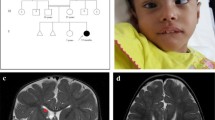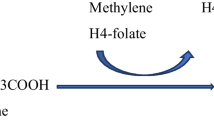Summary
Non-ketotic hyperglycinaemia (NKH) is a well-recognized metabolic cause of life-threatening illness in the neonate. The fundamental defect is in the glycine cleavage system, which consists of four protein components. Our study revealed that the majority of NKH patients had a specific defect in P-protein (glycine decarboxylase). The primary lesion of NKH at gene level was investigated, using cDNA encoding human glycine decarboxylase. A three-base deletion resulting in deletion of Phe756 was found in a Japanese patient with NKH. The majority of NKH patients in Finland, where there is a high incidence of NKH, were found to be due to a common mutation, a point mutation resulting in the amino acid substitution of Ile564 for Ser564. Prenatal diagnosis is feasible by determining the activity of the glycine cleavage system and is also possible by DNA analysis. Recent findings suggest that a high concentration of glycine in the brain may contribute to the pathophysiology of NKH by overactivatingN-methyl-d-aspartate receptors allosterically, which may result in intracellular calcium accumulation, DNA fragmentation and neuronal death. These provide the possibility that early treatment withN-methyl-d-aspartate receptor antagonist may prevent brain damage in NKH.
Similar content being viewed by others
References
Daly EC, Nadi NS, Aprison MH (1976) Regional distribution and properties of the glycine cleavage system within the central nervous system of the rat.J Neurochem 26: 179–185.
Fujiwara K, Okamura-Ikeda K, Motokawa Y (1987) Amino acid sequence of the phosphopyridoxyl peptide from P-protein of the chicken liver glycine cleavage system.Biochem Biophys Res Commun 149: 621–627.
Hayasaka K, Tada K, Kikuchi G, Winter S, Nyhan WL (1983) Nonketotic hyperglycinemia: two patients with primary defects of P-protein and T-protein, respectively, in the glycine cleavage system.Pediatr Res 17: 926–970.
Hayasaka K, Tada K, Fueki N et al (1987) Feasibility of prenatal diagnosis of nonketotic hyperglycinemia: existence of the glycine cleavage system in placenta.J Pediatr 110: 124–126.
Hayasaka K, Tada K, Fueki N, Aikawa J (1990) Prenatal diagnosis of nonketotic hyperglycinemia: Enzymatic analysis of the glycine cleavage system in chorionic villi.J Pediatr 116: 444–445.
Homosb A, Johnston MV, McDonald JW, Francamano C, Niedermeyer E, Valle D (1991) One-year experience with combination benzoate and excitatory amino acid antagonist therapy for nonketotic hyperglycinemia (abstract of 20th Annual Meeting of Child Neurology Society).Ann Neurol 30: 469.
Hosli EHL, Schousboe A (1986) Amino acid uptake. In Sergy F, Antonia V, eds.Astrocytes: Biochemistry, Physiology, and Pharmacology of Astrocytes, Vol. 2. Orlando: Academic Press, 133–153.
Johnson JW, Ascher P (1987) Glycine potentiates the NMDA response ín cultured mouse brain neurons.Nature (London)325: 529–531.
Kikuchi G (1973) The glycine cleavage system: Composition, reaction mechanism, and physiological significance.Mol Cell Biochem 1: 169–187.
Kure S, Narisawa K, Tada K (1991a) Structural and expression analyses of normal and mutant mRNA encoding glycine decarboxylase: Three base deletion in mRNA causes nonketotic hyperglycinemia.Biochem Biophys Res Commun 174: 1176–1182.
Kure S, Tominaga T, Yoshimoto T, Tada K, Narisawa K (1991b) Glutamate triggers internucleosomal DNA cleavage in neuronal cells.Biochem Biophys Res Commun 179: 39–45.
Kure S, Narisawa K, Tada K (1992a) Enzymatic diagnosis of nonketotic hyperglycinemia with lymphoblasts.J Pediatr 120: 95–98.
Kure S, Takayanagi M, Narisawa K, Tada K, Leisti J (1992b) Identification of a common mutation in Finnish patients with nonketotic hyperglycinemia.J Clin Invest 90: 160–164.
Larson AA, Beitz AJ (1988) Glycine potentiates strychinine induced convulsions: role of NMDA receptors.J Neurosci 8: 3822–3826.
McDonald JW, Johnston MV (1990) Physiological and pathophysiological roles of excitatory amino acids during central nervous system development.Brain Res Rev 15: 41–70.
Monaghan DT, Cotman CW (1985) Distribution ofN-methyl-d-aspartate-sensitivel-[3H]glutamate binding sites in rat brain.J Neurosci 5: 2909–2919.
Motokawa Y, Kikuchi G (1971) Glycine metabolism in rat liver mitochondria. Intramitochondrial localization of the reversible glycine cleavage system and serine hydroxymethyl-transferase.Arch Biochem Biophys 146: 461–466.
Norenberg MD (1979) The distribution of glutamine synthase in the rat central nervous system.J Histochem Cytochem 27: 756–762.
Nyhan WL (1989) Nonketotic hyperglycinemia. In Scriver CR, Beaudet AL, Sly WS, Valle D, eds.The Metabolic Basis of Inherited Disease, 6th edn. New York: McGraw-Hill, 743–753.
Ohya Y, Ochi N, Mizutani N, Hayakawa C, Watanabe K (1991) Nonketotic hyperglycinemia: Treatment with NMDA antagonist and consideration of neuropathogenesis.Pediatr Neurol 7: 65–68.
Perry TL, Urquhart N, McLean J et al (1975) Nonketotic hyperglycinemia.N Engl J Med 292: 1269–1273.
Sato K, Yoshida S, Fujiwara K, Tada K, Tohyama M (1991) Glycine cleavage system in astrocytes.Brain Res 567: 64–70.
Tada K (1987) Nonketotic hyperglycinemia: Clinical and metabolic aspects.Enzyme 38: 27–35.
Tada K (1988) Pathogenesis and prenatal diagnosis of nonketotic hyperglycinemia.Nipponrinsho 46: 1865–1877.
Tada K (1990) Nonketotic hyperglycinemia. In Fernandes J, Saudubray JM, Tada K, eds.Inborn Metabolic Diseases. Heidelberg: Springer-Verlag, 323–329.
Tada K (1991) Nonketotic hyperglycinemia: Pathogenesis and diagnosis.Nihon Sententaishaijo Gakkai Zasshi 7: 1–13.
Tada K (1992) Nonketotic hyperglycinemia: A life-threatening disorder in the neonate.Early Human Dev 29 75–81.
Tada K, Hayasaka (1987) Nonketotic hyperglycinemia: Clinical and biochemical aspects.Eur J Pediatr 146: 221–227.
Tada K, Narisawa K, Yoshida T et al (1969) Hyperglycinemia: a defect in glycine cleavage reaction.Tohoku J Exp Med 98: 289–296.
Von Wendt L, Hirvasniemi A, Simila S (1979) Nonketotic hyperglycemia: A genetic study of 13 Finnish families.Clin Genet 15: 411–417.
Young AB, Snyder SH (1973) Strychinine binding associated with glycine receptors of the central nervous system.Proc Natl Acad Sci USA 70: 2832–2836.
Zarbin MA, Wamsley JK, Kuhar MJ (1981) Glycine receptor: Light microscopic autoradiographic localization with [3H]strychinine.J Neurosci 1: 532–547.
Author information
Authors and Affiliations
Rights and permissions
About this article
Cite this article
Tada, K., Kure, S. Non-ketotic hyperglycinaemia: Molecular lesion, diagnosis and pathophysiology. J Inherit Metab Dis 16, 691–703 (1993). https://doi.org/10.1007/BF00711901
Issue Date:
DOI: https://doi.org/10.1007/BF00711901




